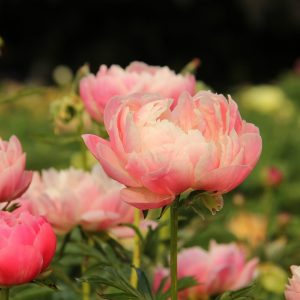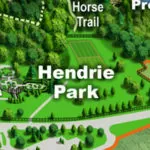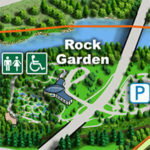| Membership | Price (+HST) |
|---|---|
| Single | $85/year |
| Single Plus | $120/year |
| Family | $130/year |
| Family Plus | $175/year |
| Contributing | $300/year |
| Supporting | $600/year |
| Sustaining | $1,000/year |
| Benefactor's Circle | $2,500/year |
| Director's Circle | $5,000/year |
| President's Circle | $10,000/year |
Irises, Roses, and Peonies in Botanical Folklore
Irises, Roses, and Peonies in Botanical Folklore
By Gianna Bazinet, Horticulture Curatorial Assistant, Royal Botanical Gardens
Autumn is a season rich with folklore. The changing leaves, autumnal equinox, and Halloween create an atmosphere that inspires the sharing of folkloric tales. We may even unearth some connections to folklore here at RBG; where collections of our floral friends have their roots entangled in human folklore. Join us on an expedition into the realm of botanical lore as we uncover the sinister secrets and mystical powers hidden within three of our most beloved plants: the enigmatic iris, the bewitching rose, and the mysterious peony.
Irises


Irises, a genus of rhizomatous flowering plants, grow naturally and in cultivation worldwide, appearing in folklore from various cultures. Known as the ‘rainbow flower’ for the range of colors they can represent the Iris genus takes it’s name from Greek mythology’s rainbow goddess Iris[i]. Since Roman times, planting Iris florentina has been a common practice for purifying areas, as the plant was believed to possess cleansing powers[ii]. The iris’s tripartite nature – three upper petals (standards), three lower petals (falls) and a trident-like profile[iii] – evokes a connection to the number 3. In Wiccan folklore, the iris’s three petals symbolize wisdom, faith, and valor. Planting irises was thought to cultivate these qualities in the gardener[iv].
Beyond the whole plant, individual parts of the iris feature in various folkloric traditions. Japanese folklore suggests hanging iris leaves (also known as fans) from house eaves to ward off evil spirits[v]. The rhizome or root can serve the same purpose[vi]. In Japanese folklore the sword-like shape of the iris leaves symbolizes protection[vii] which may be why they are hung for this purpose in the home or associated with Children’s Day[viii] .
The rhizome of Iris germanica or Iris pallida, commonly known as orris root, was called Queen Elizabeth Root in UK folklore[ix]. It can still be purchased under this historic name today, a ghostly echo of legends past.
Orris root, a staple in many traditional medicine systems, also appears prominently in a variety of arcane arts. The dried roots are believed to have various magical uses, depending on the plant variety, preparation, or combination[x]. In Hoodoo or Wiccan traditions orris root – carried close or scattered afar as powder – is thought to attract and ensnare love[xi]. Irises are also associated with the Venus planet of love in astrology[xii]. Perhaps this romantic quality might add further credence to its frequent use in modern perfumery! Oil made from orris root is also believed to possess magical properties related to love[xiii].
For those more interested in divination than romance, orris root burned with celery seed may enhance psychic abilities[xiv]. When hung from a string, it can also be used as a divination pendulum[xv]. Finally, for those seeking a more literal fortune, the root of Iris versicolor is said to summon financial prosperity when carried or improve business when kept in a cash register[xvi].
Roses


Beneath the rose’s alluring beauty lies a tangled history of love, power, and death. These crimson blooms have long been associated with matters of the heart, but their folklore is not always rosy.
In the lore of magical practice, rose petals are believed to amplify the potency of spells, their sweet scent masking more sinister intentions[i]. The Romans, in their decadent feasts, would wreathe themselves in roses and fill their wine with petals, as the roses were thought to create a wholesome feeling[ii]. Rose tonics for love are common threads in Indian and European folklore[iii].
In Wiccan tradition, a rose can be worn when performing love spells or placed on the altar to amplify the efficacy of love magic [iv] As night falls on Midsummer’s Eve, those brave enough to place a red rose under their pillow may dream of their future spouse[v]—but be warned, for such knowledge comes at a price. The rose’s connection to Venus, planet of love, makes it a powerful tool in matters of the heart [vi]
Even in death, the rose holds sway. In the misty hills of the UK’s North Shropshire, roses once lined the coffins of the poor, their beauty a final comfort in the cold embrace of the grave[vii]. Even today one can hear the mournful strains of the folk song the “The Unfortunate Rake” wherein the unlucky narrator who suffers the fallout of a doomed love requests bunches of roses for his coffin[viii].
Peonies


In the twilight world of myth and magic, the peony stands as both protector and potential curse. Named for Paeon, physician to the Greek gods[i], in Greek mythology this bloom was the first to be used in medicine and it is also thought to have mystical properties[ii]. Although. Greek legends are not the only ones to feature this ancient plant. Legend whispers that peonies can exorcise malevolent spirits and break the most powerful of enchantments[iii].
As the sun sets on All Hallows’ Eve, the peony’s association with Sunday and the celestial body itself takes on a more ominous tone[iv]. Peonies are thought to have protective powers[v]. The seeds or roots worn around the neck can ward off mischievous spirits. Wiccan tradition suggests that peony seeds, which can be carried or placed in the home for protection, should be gathered only at night[vi].
This Halloween, as you wander through gardens shrouded in mist and moonlight, remember the dark tales that cling to even the most beautiful of blooms. For in the world of botanical folklore, beauty and terror walk hand in hand, and the line between blessing and curse is as thin as a rose petal. Will you dare to unlock the secrets hidden within these enchanted flora? The choice is yours, but remember—in the realm of plant magic, nothing comes without a price. The iris watches, the rose entices, and the peony waits, all silent witnesses to humanity’s eternal dance with the supernatural.
Iris
[i] Quinn, V. (1939). Stories and Legends of Garden Flowers. United States: F.A. Stokes.
[ii] Cunningham, S. (1985). Cunningham’s Encyclopedia of Magical Herbs. United States: Llewellyn Publications.
[iii] https://www.leonineiris.com/l9ie_irisbasics.php
[iv] Cunningham, S. (1985). Cunningham’s Encyclopedia of Magical Herbs. United States: Llewellyn Publications.
[v] https://aikidocenterla.com/blog/2225
[vi] https://riteofritual.com/products/ritual-herbs-orris-root
[vii] https://kyotogardenexperience.com/author/markhovane/
[viii] Plant-lore Studies: Papers Read at a Joint Conference of the Botanical Society of the British Isles and the Folklore Society, Held at the University of Sussex, April 1983. (1984). United Kingdom: Folklore Society.
[ix] https://thewitchery.ca/product/queen-elizabeth-orris-root-chips/
[x] Cunningham, S. (1985). Cunningham’s Encyclopedia of Magical Herbs. United States: Llewellyn Publications.
[xi] https://thewitchery.ca/product/queen-elizabeth-orris-root-chips/
[xii] Dugan, E. (2012). Garden Witch’s Herbal: Green Magick, Herbalism & Spirituality. United States: Llewellyn Worldwide, Limited.
[xiii] https://parfumplusmag.com/ingredient/orris-secret-love-potion/
[xiv] Cunningham, S. (1985). Cunningham’s Encyclopedia of Magical Herbs. United States: Llewellyn Publications.
[xv] https://www.theancientsage.com/orris-root/?srsltid=AfmBOoqxaFprYmeVb8XRILoQlzefqZfBncMd4rfxz2QsV2JzbfMnJNOi
[xvi] Cunningham, S. (1985). Cunningham’s Encyclopedia of Magical Herbs. United States: Llewellyn Publications.
Rose
[i] Leyel, C. F. (1970). Elixirs of Life. United Kingdom: Stuart & Watkins.
[ii] Leyel, C. F. (1970). Elixirs of Life. United Kingdom: Stuart & Watkins.
[iii] Leyel, C. F. (1970). Elixirs of Life. United Kingdom: Stuart & Watkins.
[iv] Cunningham, S. (1985). Cunningham’s Encyclopedia of Magical Herbs. United States: Llewellyn Publications.
[v] Plant-lore Studies: Papers Read at a Joint Conference of the Botanical Society of the British Isles and the Folklore Society, Held at the University of Sussex, April 1983. (1984). United Kingdom: Folklore Society.
[vi] Dugan, E. (2012). Garden Witch’s Herbal: Green Magick, Herbalism & Spirituality. United States: Llewellyn Worldwide, Limited.
[vii] Plant-lore Studies: Papers Read at a Joint Conference of the Botanical Society of the British Isles and the Folklore Society, Held at the University of Sussex, April 1983. (1984). United Kingdom: Folklore Society.
[viii] Plant-lore Studies: Papers Read at a Joint Conference of the Botanical Society of the British Isles and the Folklore Society, Held at the University of Sussex, April 1983. (1984). United Kingdom: Folklore Society.
Peony
[i] Plant-lore Studies: Papers Read at a Joint Conference of the Botanical Society of the British Isles and the Folklore Society, Held at the University of Sussex, April 1983. (1984). United Kingdom: Folklore Society.
[ii] Plant-lore Studies: Papers Read at a Joint Conference of the Botanical Society of the British Isles and the Folklore Society, Held at the University of Sussex, April 1983. (1984). United Kingdom: Folklore Society.
[iii] Plant-lore Studies: Papers Read at a Joint Conference of the Botanical Society of the British Isles and the Folklore Society, Held at the University of Sussex, April 1983. (1984). United Kingdom: Folklore Society.
[iv] Dugan, E. (2012). Garden Witch’s Herbal: Green Magick, Herbalism & Spirituality. United States: Llewellyn Worldwide, Limited.
[v] Cunningham, S. (1985). Cunningham’s Encyclopedia of Magical Herbs. United States: Llewellyn Publications.
[vi] Cunningham, S. (1985). Cunningham’s Encyclopedia of Magical Herbs. United States: Llewellyn Publications.
More from the RBG Blog
Check out RBG’s blog for announcements, articles, and more from Canada’s largest botanical garden.
Want to be sure you hear first? Sign up for our weekly e-newsletter to hear about upcoming events, weekend activities, articles, and more!












